On The Origin of the Tetrapod Limb
- Daniel Luna
- Biological Sciences Collegiate Division, The University of Chicago
- BIOS 12117: The 3.5 Billion Year History of the Human Body
- Dr. Neil Shubin
- December 6, 2022
Abstract
Life on earth began in water, yet life is also present on land today. This transition from sea to land began with the tetrapod. This major evolutionary step did not occur overnight, but instead is still ongoing, the foundational blueprint laid millions of years ago during the Devonian period is still followed. Limbs, the defining characteristics of tetrapods, play an essential role in modern life and cannot be ignored. For this reason, to better understand modern limbs and, by extension, modern tetrapods, we must first understand the origins of limbs in tetrapods. However, multiple approaches can answer this question of how limbs in tetrapods originated. We will showcase the various perspectives used to answer this vital question and show that the limbs of tetrapods have origins in fish fins. Introduction Tetrapods mark the beginning of the transition of life from sea to land. A critical characteristic of all tetrapods is having four limbs, hence the prefix ‘tetra’. A crucial question that arises is how did the limbs of tetrapods evolve? How did their limbs originate? This question is deceptive in that it appears a simple question to answer, yet depending on how the interpretation of the question can lead to various answers.
History
The question of how tetrapod limbs originated has supposedly been posed for 2,700 years. Some say that Aristotle first recognized the similarities between a fish fin and a tetrapod limb. In modern times, researchers have attempted to answer this question using various methods and disciplines within biology. The techniques range from comparative anatomy to fossil records to studying genes and development. The journey of modern research into the origins of limbs in tetrapods began with Richard Owen in the 19th century. Owen used homologies he could find as evidence of descent between two species. Following Owen, throughout the 20th century, the focus was put on fossil records and morphology to answer this vital question. After the discovery of DNA and the advancement of modern technology, the focus shifted to comparing genomes. This new DNA technology gave rise to Evolutionary Developmental Biology, which attempts to answer evolutionary questions through the context of development.
Importance
While the tetrapod limb originated hundreds of millions of years ago during the middle to late Devonian period, the foundations laid then are still present in modern-day tetrapods such as humans. Knowing how limbs originated can help us understand why limbs evolved the way they did and when they did. Additionally, the continual research into this question is leading to new advancements in various disciplines within biology which can help us understand better and answer other questions that some may view as more important than this one.
Analysis
This paper will cover various methods used within biology that attempt to answer the question of the origin of the tetrapod: comparative anatomy and fossil records, evolutionary developmental biology, and cladistics. This section will conclude with a conclusion section that will attempt to unite these different interpretations linking the origin of the tetrapod limbs to fish fins.
Comparative Anatomy and Fossil Records
The only way we have to look at extinct species that lived millions of years ago is through their fossils left behind in rocks. Comparative anatomy is the most robust of the techniques listed in this paper. This technique was used by Richard Owen and still is by many researchers today. In this discipline, we study the likes of the first tetrapods like Tiktaalik roseae (Shubin et al., 2006), and compare them to other fossils from a similar time period to show common ancestry. The typical way to show common ancestry using comparative anatomy is through homology. From the skeleton of a modern tetrapod limb we can notice that it follows the pattern of one bone, two bones, many bones, then digits, as best shown in Fig. 2A. As seen in Fig. 1, this pattern can also be seen in fossils of fins from the Devonian period. Fig. 1D is a tetrapod limb, and there is a correlation for all the different shading levels of the fins in Fig. 1A-C. Furthermore, by analyzing the various fins and limbs, patterns arise which remain as a result of evolution. It is with these patterns that the connections between species can be justified.
Evolutionary Developmental Biology
Evolutionary Developmental Biology (Evo. Devo.) is the newest of the three disciplines. Unlike comparative anatomy and using fossil records, Evo. Devo. is more quantitative. After analyzing genome sequences, we can then use a tool like CRISPR to alter specific genes. Evo. Devo. focuses primarily on development, as a result embryos are raised with these modified genes with the alterations being recorded. Within Evo. Devo. there is an area that focuses on conservation of specific genes through evolution. An essential one is the Hox gene. The Hox gene is highly conserved amongst vertebrates, is found in clusters, and is uninterrupted by other genes. (Santani et al., 2003) Since it is highly conserved, it would follow that all species would look the same; while the gene itself might be near identical between species, the regulators are not. These so-called enhancers alter the expression of the Hox gene throughout the development phases. Different enhancers and their balance, both new and conserved, might provide the basis for interspecies differences, as shown in Fig. 3. The Hox gene is so well conserved that most enhancers can be transplanted between modern species as far apart as fish and mice. When enhancers are transplanted in fish and mice, late phase Hox expression in the fish and mouse were found to be homologous. (Gehrke et al., 2014) Furthermore, there is evidence that the same bimodal chromatin architecture that is found in tetrapod limbs can also be found in fish embryos. This hints to the regulatory mechanism predating the divergence between fish and tetrapods. (Woltering et al., 2014)
Cladistics
The results of comparative anatomy and evolutionary developmental biology can be written down, pair by pair, however this would be inefficient. Instead, a cladogram is generated to demonstrate the relationship between species serving as a visual representation and aid. Cladograms are dependent on how it is categorized. For instance, the cladograms in both Fig. 5 and 6 are phylogenetic. In Fig. 5, tetrapods are shown to be the farthest branch, or least related to coelacanths, and most related to the branch of panderichthys. The categories used were different species of sarcopterygian, where tetrapods are believed to have evolved. Fig. 6 instead focuses more on the various taxa of tetrapods. This hypothesis supposes that autopods arose only once from a common ancestor, which they share with panderichthys. Phylogenetic cladograms are just one type of cladogram. There also are cladograms based on comparative anatomy, such as Fig. 7. This cladogram is formed by seeing how present distinct visual cues are between species. Since fish are more primitive than tetrapods, it would be expected that fish have the least in common, or less defined features as compared to tetrapods. Tiktaalik, as one of the oldest tetrapods that has been discovered placed directly in between Elpistostege and Panderichthys, Lobed-Finned Fish (Cloutier et al., 2020).
Conclusion
There have been over 200 years of research into the source of the tetrapod limb, and that list of literature is still growing as discoveries using even more advanced techniques and technologies in biology are made. This paper is a partial list of all the research on the origin of the tetrapod limb. The analysis using fossils from the Devonian period demonstrates homologous features between the first tetrapods and fish fins from a similar time. Furthermore, between modern fish and tetrapods, there exist lots of well-conserved genes in their genomes, such as the Hox gene. The differences primarily lie in the regulation of these genes throughout development. Combining both previously mentioned techniques allows us to create cladograms that attempt to place tetrapods into the greater tree of life. Like the other techniques, this is not perfect, far from it. Multiple methods exist to create these cladograms, which result in varying results on how tetrapod limbs originated. However, regardless of the method used to develop the cladograms, a common ancestor of modern-day tetrapods to fish exists. So the various techniques, such as those discussed, suggest tetrapod limbs originated from fish fins.
Discussion
A question that attempts to answer something that happened millions of years ago with no written record is complex. To say that only one technique answers this question would be an understatement. Using multiple approaches to the same question gives us the best opportunity to uncover the proper answer. Two significant consequences arise, one is a result of attempting to find an answer to this question, and the other is based on the suggestion that our current research has provided. Firstly, various techniques have been developed and improved while attempting to answer this question. These techniques can help answer other questions which remain unanswered. For instance, evolutionary developmental biology is still a growing field that nowadays analyzes genes, DNA, and so much more to see how evolution happened through the perspective of development. Further, studying development allows us to see descent through patterns within the development process. Additionally, the “older” and much more refined comparative anatomy is not staying behind. It is seeing new possibilities powered by modern technology which didn’t exist even a decade ago. It is also vital in filling in the gap when we do not have access to a species’ genome. Secondly, the idea that tetrapod limbs originated from fish fins also has many implications. Many of the structures are homologous between each and, as a result, are a potential area of interest in comparative physiology. Furthermore, it must be noted that limbs are only one evolution necessary to support life primarily on land. Researchers could apply similar techniques to focus more broadly on the transition from sea to land. There is still much more to uncover about the origin of the tetrapod limb. It is essential to recognize that the research required to solve this question is done with a purpose. The advancements achieved while attempting to answer this question will lead to new ideas which will inspire a generation to answer their important questions. As for the current question, from our current understanding, it is suggested that tetrapod limbs originated from fish fins.
References
Coates, M. I., Jeffery, J. E. & Ruta M. Fins to limbs: what the fossils say. Evolution & Development 4, 390-401 (2002). https://doi.org/10.1046/j.1525-142X.2002.02026.x
Cloutier, R., Clement, A. M., Lee, M. S. Y., Noël, R., Béchard, I., Roy, V. & Long, J. A. Elpistostege and the origin of the vertebrate hand. Nature 579, 549–554 (2020). https://doi.org/10.1038/s41586-020-2100-8
Gehrke, A. R., Schneider, I., de la Calle-Mustienes, E., Tena, J. J., Gomez-Martin, C., Chandran, M., Nakamura, T., Braasch, I., Postlethwait, J. H., Gómez-Skarmeta, J. L. & Shubin, N. H. Deep conservation of wrist and digit enhancers in fish. Proceedings of the National Academy of Sciences 112, 803-808 (2014). https://doi.org/10.1073/pnas.1420208112
Santani, S., Boore, J. L. & Meyer, A. Evolutionary Conservation of Regulatory Elements in Vertebrate Hox Gene Clusters. Genome Research 13, 1111-1122 (2003). https://doi.org/10.1101/gr.700503
Shubin, N. H., Daeschler, E. B. & Jenkins, F. B. The pectoral fin of Tiktaalik roseae and the origin of the tetrapod limb. Nature 440, 764–771 (2006). https://doi.org/10.1038/nature04637
Wagner, G. P. & Chiu, C.-H. The tetrapod limb: a hypothesis on its origin. Journal of Experimental Zoology 291, 226–240 (2001). https://doi.org/10.1002/jez.1100
Woltering, J. M., Noordermeer, D., Leleu, M. & Duboule, D. Conservation and Divergence of Regulatory Strategies at Hox Loci and the Origin of Tetrapod Digits. PLOS Biology 12, (2014). https://doi.org/10.1371/journal.pbio.1001773
Figures and Captions
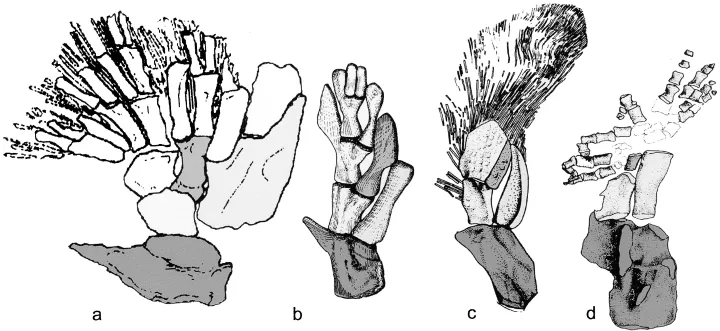
Figure 1. Comparison of Multiple Fins to a Limb. (a) Sauripterus pectoral fin. (b) Eusthenopteron, a tristichopterid. (c) Panderichthys. (d) Acanthostega. Gray shading indicates homologous structures in different limbs. Figure from Coates et al., 2002.

Figure 2. Comparison of a Limb to a Fin to an Intermediate. (A) Typical tetrapod limb. (B) Pectoral fin of a blenny. (C) Endoskeleton of Eusthenopteron, relative of tetrapods. Figure from Wagner & Chiu, 2001.
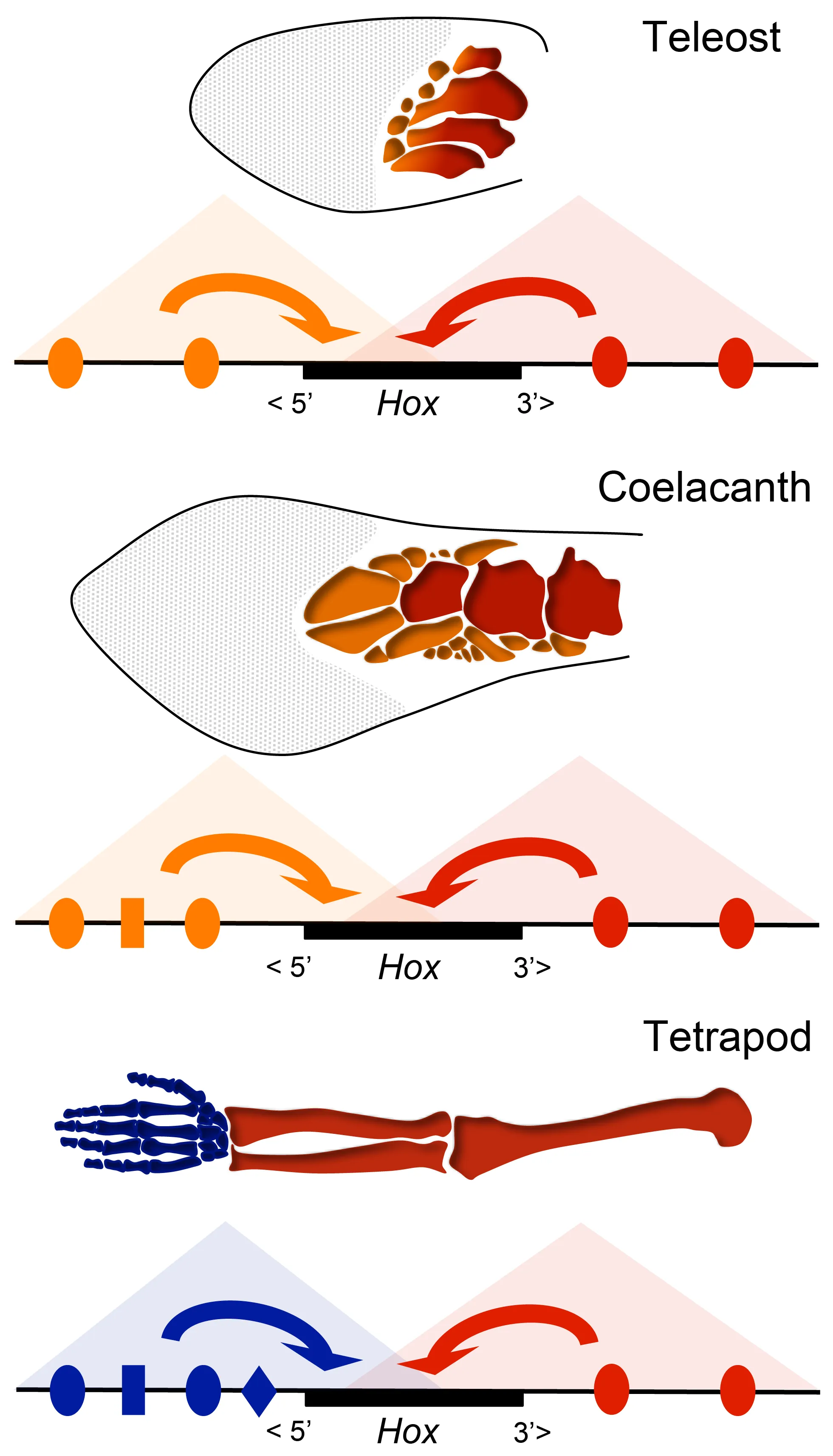
Figure 3. Results of Hox Genes after Development. The Hox gene is common amongst the 3 species. The different shapes are enhancers which interact with the gene. Figure from Woltering et al., 2014.

Figure 4. Results of Transplantation of Enhancers. Figure from Gehrke et al., 2014.
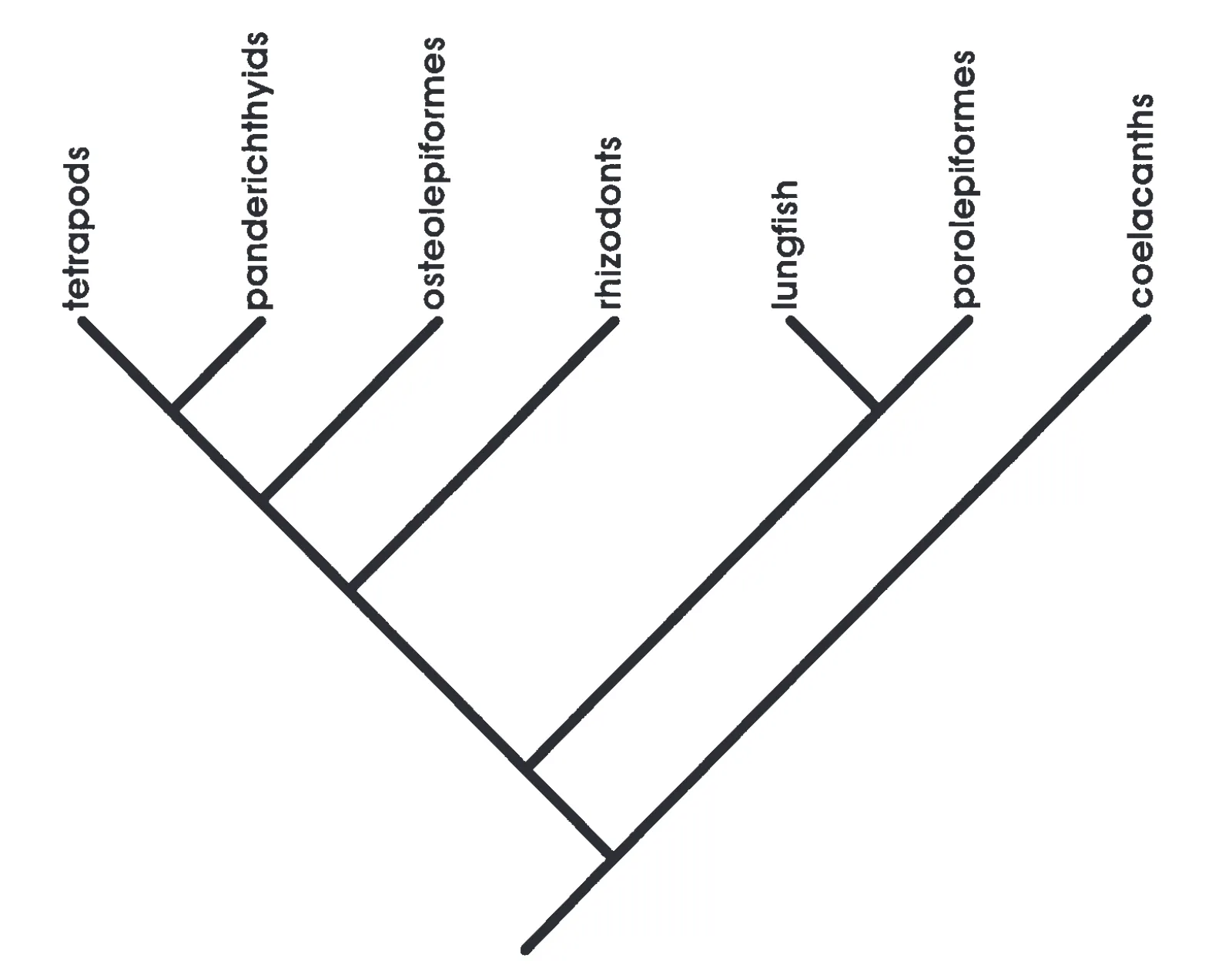
Figure 5. Cladogram 1. This cladogram demonstrates tetrapods amongst its close sarcopterygian relatives. Figure from Wagner & Chiu, 2001.
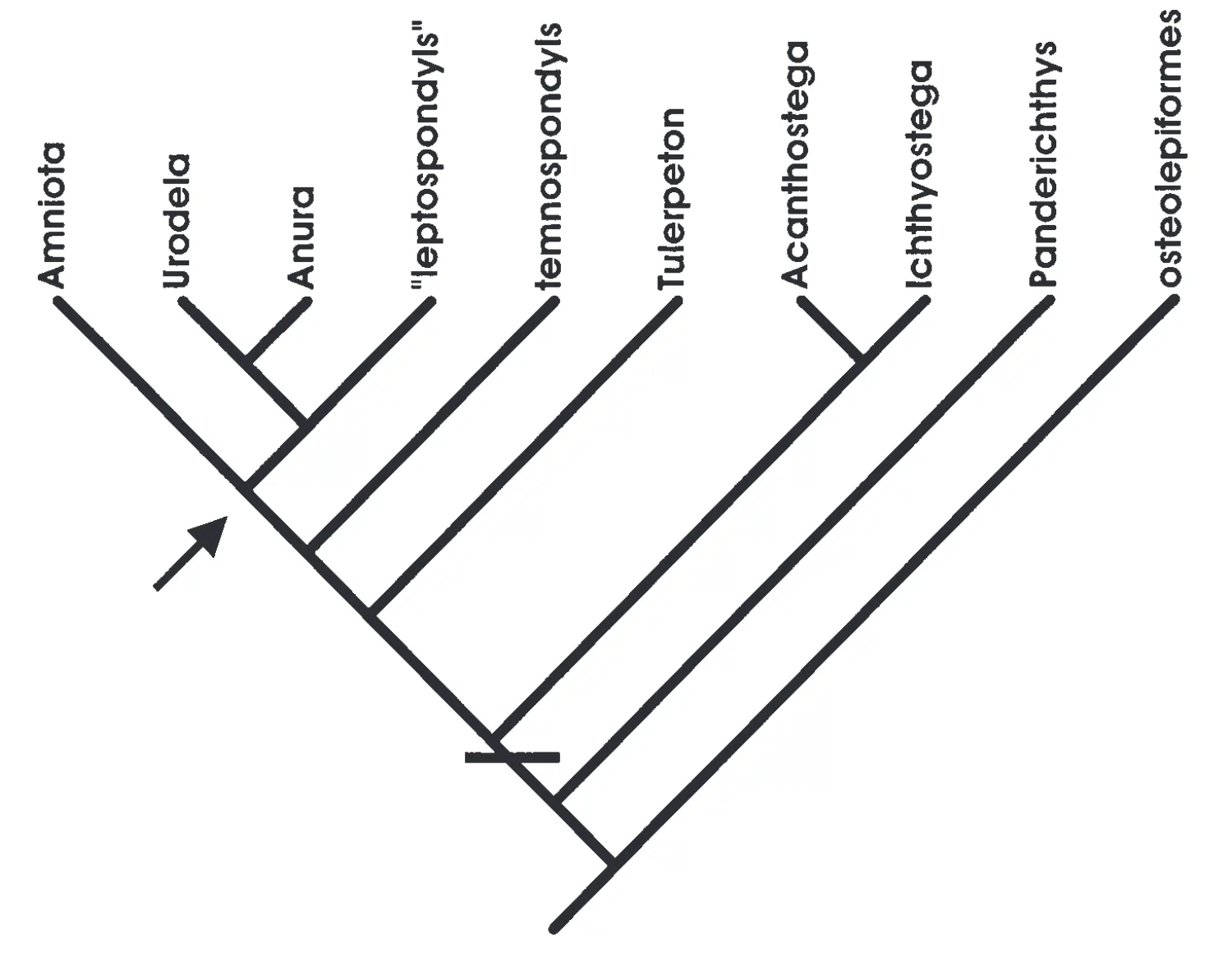
Figure 6. Cladogram 2. The arrow represents the last common ancestor of living tetrapods. The line represents the fin-limb transition. Figure from Wagner & Chiu, 2001.
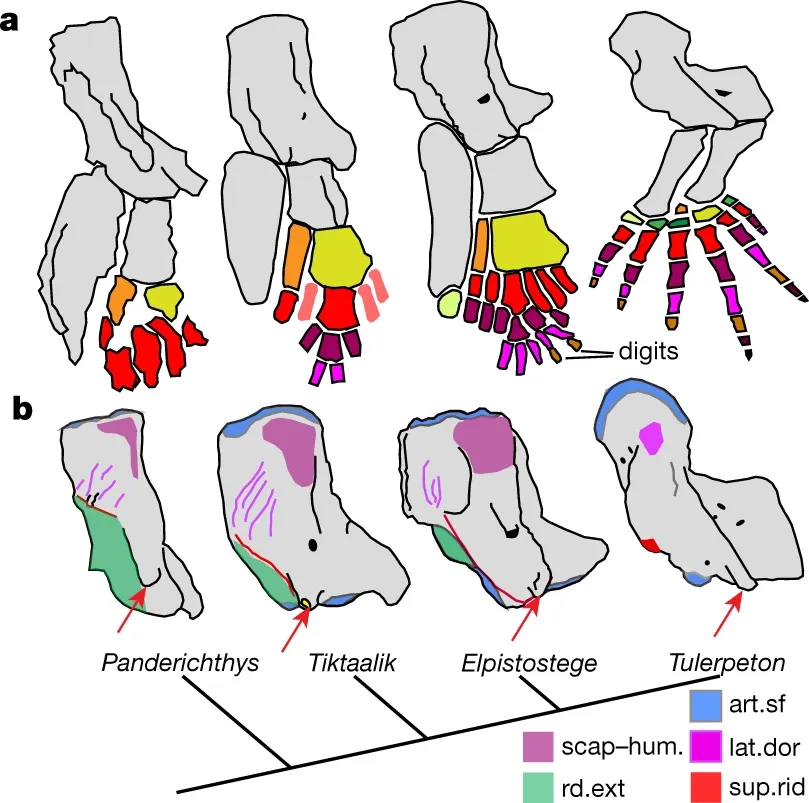
Figure 7. Comparative Anatomy Cladogram. This cladogram is based on the comparative anatomy of fish and the first tetrapods. Figure from Cloutier et al., 2020.